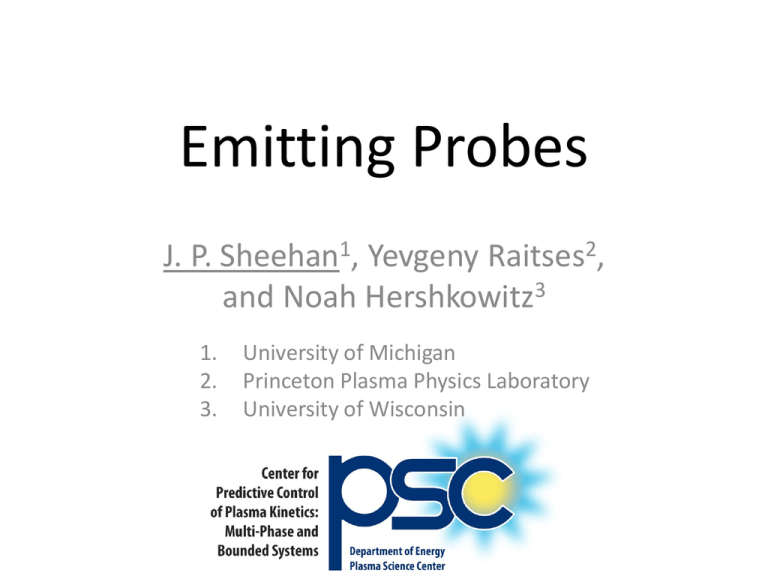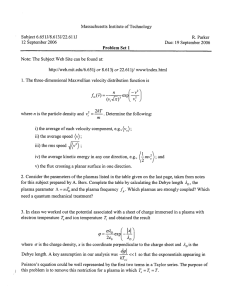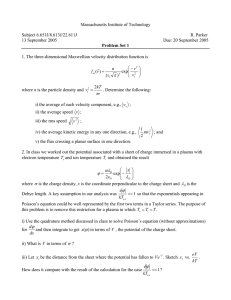Emitting Probes J. P. Sheehan , Yevgeny Raitses ,
advertisement

Emitting Probes J. P. Sheehan1, Yevgeny Raitses2, and Noah Hershkowitz3 1. 2. 3. University of Michigan Princeton Plasma Physics Laboratory University of Wisconsin Summary of Topics • Methods for measuring plasma potential • Emissive sheath theory • Heating schemes • Probe construction • Special case considerations • Choosing an emissive probe Fundamental Processes, Modeling and Diagnostics of Low-Temperature Plasmas, Princeton, NJ, Sep. 29, 2013 2 Why use an emissive probe? • Measure the electrostatic potential • Can be used to infer electric fields and particle flows • Versatile • Robust • Proven and established J. P. Sheehan, Y. Raitses, N. Hershkowitz, I. Kaganovich and N. J. Fisch, Physics of Plasmas 18 (7), 073501 (2011). Fundamental Processes, Modeling and Diagnostics of Low-Temperature Plasmas, Princeton, NJ, Sep. 29, 2013 3 Start from Langmuir probe I-V trace • Ions contribute negative current, electrons positive current • In Maxwellian plasma, electron current exponential below plasma potential • Above plasma potential current limited only be geometry Fundamental Processes, Modeling and Diagnostics of Low-Temperature Plasmas, Princeton, NJ, Sep. 29, 2013 Vp = 0 V Te = 1 eV 4 Emission current modifies I-V trace below plasma potential • Electrons can only be emitted when probe biased below plasma potential • Emission current limited by temperature of probe 𝑗𝑒𝑒,𝑡 = 𝐴𝐺 𝑇𝑤2 exp − 𝑒𝜙𝑤 𝑇𝑤 • Below plasma potential IV trace modified by emission, above it stays the same Fundamental Processes, Modeling and Diagnostics of Low-Temperature Plasmas, Princeton, NJ, Sep. 29, 2013 5 Separation point technique • Earliest method, formulated by Langmuir • Assumes emitted electrons are cold • Plasma potential is the point where Langmuir I-V and emissive I-V traces separate • Very time consuming before computer automation Fundamental Processes, Modeling and Diagnostics of Low-Temperature Plasmas, Princeton, NJ, Sep. 29, 2013 6 Electron emission reduces the sheath potential and electric field • In collecting sheath, net positive space-charge • Emitted electrons reduce net space charge • Reduce sheath potential • Reduce electric field at emitter surface • Increased plasma electron current compensated by emitted electron current Fundamental Processes, Modeling and Diagnostics of Low-Temperature Plasmas, Princeton, NJ, Sep. 29, 2013 7 A SCL emitting surface floats Tep/e below the plasma potential • At large enough emission current, net negative spacecharge near surface • Virtual cathode forms, limiting further reduction of sheath potential • At Space-Charge Limit (SCL) emissive sheath potential is Tep/e • SCL sheath much smaller potential than collecting sheath Fundamental Processes, Modeling and Diagnostics of Low-Temperature Plasmas, Princeton, NJ, Sep. 29, 2013 Space-Charge Limited Solution Φ𝑤 = − 𝑒ϕ𝑤 = 1.02 𝑇𝑒𝑝 8 G. D. Hobbs and J. A. Wesson, Plasma Physics 9 (1), 85 (1967). Emissive sheaths require a presheath • Needed to accelerate ions • Slightly modified by emitted electrons • Adds additional ~0.5 – 1.0 Te/e • Length scale determined by – Charge-exchange collisions – Ionization – Geometry K. U. Riemann, Journal of Physics D-Applied Physics 24 (4), 493-518 (1991). Fundamental Processes, Modeling and Diagnostics of Low-Temperature Plasmas, Princeton, NJ, Sep. 29, 2013 9 Floating point technique R. F. Kemp and J. M. Sellen, Review of Scientific Instruments 37 (4), 455 (1966). Fundamental Processes, Modeling and Diagnostics of Low-Temperature Plasmas, Princeton, NJ, Sep. 29, 2013 10 • Plasma potential is floating potential of highly emissive probe • Error of ~1.5Tep/e • Most popular method • Robust • Easy to execute Kinetic effects reduce the electron density near the surface Plasma electrons lost to surface Fundamental Processes, Modeling and Diagnostics of Low-Temperature Plasmas, Princeton, NJ, Sep. 29, 2013 Emitted electron temperature 11 Emissive sheath potential is reduced by the emitted electron temperature J. P. Sheehan, N. Hershkowitz, I. D. Kaganovich, H. Wang, Y. Raitses, E. V. Barnat, B. R. Weatherford and D. Sydorenko, Physical Review Letters 111 (7), 075002 (2013). Fundamental Processes, Modeling and Diagnostics of Low-Temperature Plasmas, Princeton, NJ, Sep. 29, 2013 12 Kinetic theory predictions were confirmed by experiments J. P. Sheehan, N. Hershkowitz, I. D. Kaganovich, H. Wang, Y. Raitses, E. V. Barnat, B. R. Weatherford and D. Sydorenko, Physical Review Letters 111 (7), 075002 (2013). Fundamental Processes, Modeling and Diagnostics of Low-Temperature Plasmas, Princeton, NJ, Sep. 29, 2013 13 Inflection point technique: developed to reduce space-charge effects • Take many I-V traces at low emission currents. Fundamental Processes, Modeling and Diagnostics of Low-Temperature Plasmas, Princeton, NJ, Sep. 29, 2013 14 Find the inflection point and temperature limited emission current for each I-V trace Fundamental Processes, Modeling and Diagnostics of Low-Temperature Plasmas, Princeton, NJ, Sep. 29, 2013 15 Extrapolate inflection point to zero emission current Fundamental Processes, Modeling and Diagnostics of Low-Temperature Plasmas, Princeton, NJ, Sep. 29, 2013 16 Fluid theory can provide justification for inflection point technique M. Y. Ye and S. Takamura, Physics of Plasmas 7 (8), 3457-3463 (2000). Fundamental Processes, Modeling and Diagnostics of Low-Temperature Plasmas, Princeton, NJ, Sep. 29, 2013 17 Inflection point technique accurate to within Tep/10e J. P. Sheehan, Y. Raitses, N. Hershkowitz, I. Kaganovich and N. J. Fisch, Physics of Plasmas 18 (7), 073501 (2011). Fundamental Processes, Modeling and Diagnostics of Low-Temperature Plasmas, Princeton, NJ, Sep. 29, 2013 18 Geometric effects demonstrate limitations to planar theories • Slope of inflection point vs. emission current dependent on probe diameter • Smaller probe – More accurate measurements – Smaller emission current – More fragile J. R. Smith, N. Hershkowitz and P. Coakley, Review of Scientific Instruments 50 (2), 210-218 (1979). Fundamental Processes, Modeling and Diagnostics of Low-Temperature Plasmas, Princeton, NJ, Sep. 29, 2013 19 Higher curvature allows emitted electrons to quickly disperse Fundamental Processes, Modeling and Diagnostics of Low-Temperature Plasmas, Princeton, NJ, Sep. 29, 2013 20 Cylindrical effects further complicate emissive probe floating potential 1 • Smaller probe radius – Ion convergence reduces net space-charge – Smaller sheath potential • Orbital motion effects – Preliminary results – May increase emitted electron density – Increase sheath potential 1. A. Fruchtman, D. Zoler and G. Makrinich, Physical review. E, Statistical, nonlinear, and soft matter physics 84 (2), 025402 (2011). 2. S. Robertson, IEEE Transactions on Plasma Science 40 (10), 2678-2685 (2012). Fundamental Processes, Modeling and Diagnostics of Low-Temperature Plasmas, Princeton, NJ, Sep. 29, 2013 21 Debye length / probe radius 2 Summary of techniques • Separation point: where collecting I-V and emitting I-V intersect • Floating point: floating potential at space-charge limit • Inflection point: in the limit of zero emission for low emission currents Fundamental Processes, Modeling and Diagnostics of Low-Temperature Plasmas, Princeton, NJ, Sep. 29, 2013 22 Emissive probe techniques were compared in Hall thruster plume J. P. Sheehan, Y. Raitses, N. Hershkowitz, I. Kaganovich and N. J. Fisch, Physics of Plasmas 18 (7), 073501 (2011). Fundamental Processes, Modeling and Diagnostics of Low-Temperature Plasmas, Princeton, NJ, Sep. 29, 2013 23 Floating potential of highly emissive probe ~2Te/e below plasma potential J. P. Sheehan, Y. Raitses, N. Hershkowitz, I. Kaganovich and N. J. Fisch, Physics of Plasmas 18 (7), 073501 (2011). Fundamental Processes, Modeling and Diagnostics of Low-Temperature Plasmas, Princeton, NJ, Sep. 29, 2013 24 AC Joule Heating • Resistive heating • Typical probe resistance: ~3Ω • Half-wave rectified heating current • Period must be shorter than cooling time (10s of ms) • Data collected during nonheating half-cycle • Inflection point and floating point may shift due to cooling Fundamental Processes, Modeling and Diagnostics of Low-Temperature Plasmas, Princeton, NJ, Sep. 29, 2013 25 M. A. Makowski and G. A. Emmert, Review of Scientific Instruments 54 (7), 830-836 (1983). DC Joule Heating • Heating current: 100s of mA to 1s of A – Depends on probe thickness • Added circuit elements can reduce noise • Data taken while probe is heated – Must account for heating potential • Large shunt resistor (10s – 100s of MΩ) for accurate measurements Fundamental Processes, Modeling and Diagnostics of Low-Temperature Plasmas, Princeton, NJ, Sep. 29, 2013 26 Laser Heating • CO2 laser (10 – 20 W) • Probe can be made of non-ductile material • Infrequently used R. W. Schrittwieser, R. Stärz, C. Ionita, R. Gstrein, T. Windisch, O. Grulke and T. Klinger, Journal of Plasma Fusion Research 8, 632-636 (2009). Fundamental Processes, Modeling and Diagnostics of Low-Temperature Plasmas, Princeton, NJ, Sep. 29, 2013 27 Emissive filament shape Hairpin R. F. Kemp and J. M. Sellen, Review of Scientific Instruments 37 (4), 455 (1966). Linear J. R. Smith, N. Hershkowitz and P. Coakley, Review of Scientific Instruments 50 (2), 210-218 (1979). Fundamental Processes, Modeling and Diagnostics of Low-Temperature Plasmas, Princeton, NJ, Sep. 29, 2013 28 Loop-Free R. Schrittwieser, A. Sarma, G. Amarandei, C. Ionita, T. Klinger, O. Grulke, A. Vogelsang and T. Windisch, 2006. Low work function materials are necessary for high emission • Thoriated tungsten wire is typical – 2% doped – 103 – 104 more emissive than undoped • Loop-free – Graphite – LaB6 • For oxygen plasmas – Rhenium – Iridium Fundamental Processes, Modeling and Diagnostics of Low-Temperature Plasmas, Princeton, NJ, Sep. 29, 2013 E. Lassner and W.-D. Schubert, (Kluwer Academic/Plenum Publishers, New York, 1999), pp. 422. 29 Connecting electrical leads Mechanical Braid S. Iizuka, P. Michelsen, J. J. Rasmussen, R. Schrittwieser, R. Hatakeyama, K. Saeki and N. Sato, Journal of Physics E-Scientific Instruments 14 (11), 1291-1295 (1981). Fundamental Processes, Modeling and Diagnostics of Low-Temperature Plasmas, Princeton, NJ, Sep. 29, 2013 A. Siebenforcher and R. Schrittwieser, Review of Scientific Instruments 67 (3), 849-850 (1996). 30 Connecting electrical leads (cont.) Spot Weld Electrolytic Etching R. F. Kemp and J. M. Sellen, Review of Scientific Instruments 37 (4), 455 (1966). Fundamental Processes, Modeling and Diagnostics of Low-Temperature Plasmas, Princeton, NJ, Sep. 29, 2013 R. W. Motley, Journal of Applied Physics 43 (9), 3711 (1972). 31 Probe shaft may perturb plasma • Dual bore alumina tube • Telescoping probe • Electrical shielding for temporal resolution • SEE in high energy density plasmas • Segmented conductive probe shaft – Tungsten or graphite – Greatly reduces plasma perturbations Fundamental Processes, Modeling and Diagnostics of Low-Temperature Plasmas, Princeton, NJ, Sep. 29, 2013 J. P. Sheehan, Y. Raitses, N. Hershkowitz, I. Kaganovich and N. J. Fisch, Physics of Plasmas 18 (7), 073501 (2011). D. Staack, Y. Raitses and N. J. Fisch, Review of Scientific Instruments 75 (2), 393-399 (2004). 32 Magnetic Fields • Changes effective probe area – Orient probe perpendicular to magnetic field • Deformation of Joule heated probe – Avoidable with laser heating • Anisotropic EVDF Fundamental Processes, Modeling and Diagnostics of Low-Temperature Plasmas, Princeton, NJ, Sep. 29, 2013 33 Temperature, density gradients • Hall thrusters, for instance • Temperature and density decrease away from thruster • Vp – Vf ≈ Te • λd / r p • Errors in electric field measurements 1. D. Staack, Y. Raitses and N. J. Fisch, Review of Scientific Instruments 75 (2), 393-399 (2004). 2. D. Staack, Y. Raitses and N. J. Fisch, Applied Physics Letters 84 (16), 3028-3030 (2004). Fundamental Processes, Modeling and Diagnostics of 34 Low-Temperature Plasmas, Princeton, NJ, Sep. 29, 2013 1 2 Sheaths • Langmuir probes cannot be used in sheaths • Floating potential method more difficult as density decreases • Inflection point method preferred • Direction of slope can identify sheath edge 1. L. Oksuz and N. Hershkowitz, Plasma Sources Science and Technology 14 (1), 201208 (2005). 2. X. Wang and N. Hershkowitz, Review of Scientific Instruments 77 (4), 043507 (2006). Fundamental Processes, Modeling and Diagnostics of Low-Temperature Plasmas, Princeton, NJ, Sep. 29, 2013 35 1 2 Radio frequency plasmas • Time averaged floating potential ambiguous • Derivative of I-V trace reveals time averaged potential oscillations • Mostly insensitive to emission current as long as Ie0 ~ 1 – 10 Ic0 E. Y. Wang, N. Hershkowitz, T. Intrator and C. Forest, Review of Scientific Instruments 57 (10), 2425-2431 (1986). Fundamental Processes, Modeling and Diagnostics of Low-Temperature Plasmas, Princeton, NJ, Sep. 29, 2013 36 Temporal Resolution • Probe acts as RC circuit 𝐶0 𝑅0 𝑅𝑀 𝜏𝑀 = 𝑅0 + 𝑅𝑀 – C0: stray capacitance – R0: sheath resistance – RM: measurement resistor • High speed op amp greatly improves response time (< 1 μs) • Laser heated probes have faster response times • Time resolved rf potentials Fundamental Processes, Modeling and Diagnostics of Low-Temperature Plasmas, Princeton, NJ, Sep. 29, 2013 37 OP AMP H. Fujita and S. Yagura, Japanese Journal of Applied Physics Part 1-Regular Papers Short Notes and Review Papers 22 (1), 148151 (1983). Slow-Sweep • Measure current vs time at many probe biases • Transpose to determine I-V trace vs time • Allows time resolved inflection point method • Easy, inexpensive to execute • Same temporal resolution as floating probe • Only for regular, period oscillations Fundamental Processes, Modeling and Diagnostics of Low-Temperature Plasmas, Princeton, NJ, Sep. 29, 2013 38 High Energy Density • High heat flux can melt probe • For I-V trace, electron saturation current can contribute to Joule heating • Self emissive probe uses plasma for heating • Fast (1 m/s) actuator removes probe before it melts M. A. Fink, M. Endler and T. Klinger, 2004. Fundamental Processes, Modeling and Diagnostics of Low-Temperature Plasmas, Princeton, NJ, Sep. 29, 2013 39 High Pressure ( >~ 1 Torr) • Electrons accelerating to/from probe can cause additional ionization • Measurements have not yet be attempted in atmospheric pressure plasma S. L. Yan, H. Kamal, J. Amundson and N. Hershkowitz, Review of Scientific Instruments 67 (12), 4130-4137 (1996). Fundamental Processes, Modeling and Diagnostics of Low-Temperature Plasmas, Princeton, NJ, Sep. 29, 2013 40 Vacuum potential measurements • Emissive probes can make vacuum potential measurements • Useful for plasma/vacuum interface • Circuit forces probe potential to draw set current • Graph shows measurements between capacitive plates Fundamental Processes, Modeling and Diagnostics of Low-Temperature Plasmas, Princeton, NJ, Sep. 29, 2013 41 D. Diebold, N. Hershkowitz, A. D. Bailey, M. H. Cho and T. Intrator, Review of Scientific Instruments 59 (2), 270-275 (1988). Probes vs. Optics • Stark broadening – Measures electric field (> 30 V/cm) – Resolution of 0.1 mm – Limited by ion electric microscopic fields • Probes – No minimum electric field – Resolution of 1 mm Fundamental Processes, Modeling and Diagnostics of Low-Temperature Plasmas, Princeton, NJ, Sep. 29, 2013 U. Czarnetzki, D. Luggenhölscher and H. F. Döbele, Physical Review Letters 81 (21), 4592-4595 (1998). 42 Recommendations: Density ne (cm-3) 𝑛𝑒 ≤ 105 𝑛𝑒 > Vacuum current bias 105 ≤ 𝑛𝑒 ≤ 1012 < 𝑛𝑒 ≤ Technique Inflection point in the limit of zero emission 1012 Inflection point in the limit of zero emission Floating point in the limit of large emission 1.8 × 1014 𝑇𝑒 Secondary electron emissive probe Floating point with self-emissive probe 1.8 × 1014 Optical techniques 𝑇𝑒 J. P. Sheehan and N. Hershkowitz, Plasma Sources Science and Technology 20 (6), 063001 (2011). Fundamental Processes, Modeling and Diagnostics of Low-Temperature Plasmas, Princeton, NJ, Sep. 29, 2013 43 Recommendation: System Plasma system Heating method Technique Vacuum Joule heating Vacuum current bias Highly magnetized plasma Laser heating Inflection point Floating point Radio frequency Double plasma device or beams Joule heating Inflection point Non-neutral Fusion plasma: bulk Fusion plasma: edge Optical techniques Laser heating Self-emission J. P. Sheehan and N. Hershkowitz, Plasma Sources Science and Technology 20 (6), 063001 (2011). Fundamental Processes, Modeling and Diagnostics of Low-Temperature Plasmas, Princeton, NJ, Sep. 29, 2013 44 Floating point Recommendation: Applications Applications Steady state potential Potential in a sheath Technique Inflection point in the limit of zero emission Real time monitoring Spatial scans Temporal development Floating point in the limit of large emission Fluctuations J. P. Sheehan and N. Hershkowitz, Plasma Sources Science and Technology 20 (6), 063001 (2011). Fundamental Processes, Modeling and Diagnostics of Low-Temperature Plasmas, Princeton, NJ, Sep. 29, 2013 45 Conclusions • Very useful tool for plasma potential measurements – Robust for a wide variety of plasmas – Good range for many low temperature plasma experiments • Don’t ignore the uncertainties of each technique – Electron temperature – Parameter gradients – Geometry Fundamental Processes, Modeling and Diagnostics of Low-Temperature Plasmas, Princeton, NJ, Sep. 29, 2013 46 Acknowledgments This work was supported by the US Department of Energy Grants No DEFG02-97ER54437 and No 3001346357 and the Fusion Energy Science Fellowship Program administered by Oak Ridge Institute for Science and Education under a contract between the US department of Energy and the Oak Ridge Associated Universities. 1. J. P. Sheehan and N. Hershkowitz, Plasma Sources Science and Technology 20 (6), 063001 (2011). 2. J. P. Sheehan, R. Raitses, N. Hershkowitz, and M. McDonald, NASA Standard (2013), submitted. Fundamental Processes, Modeling and Diagnostics of Low-Temperature Plasmas, Princeton, NJ, Sep. 29, 2013 47




